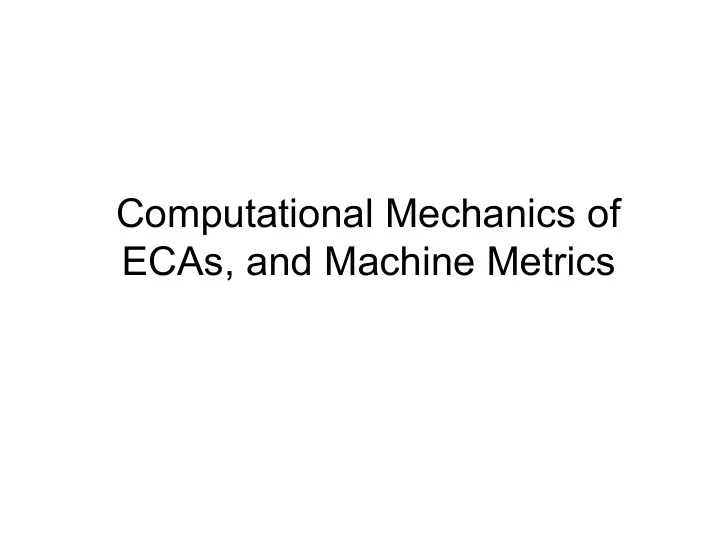

Computational Mechanics of ECAs, and Machine Metrics
Elementary Cellular Automata • 1d lattice with N cells (periodic BC) • Cells are binary valued {1,0} -- B or W • Deterministic update rule, Φ , applied to all cells simultaneously to determine cell values at next time step. • nearest neighbor interactions only
Example - Rule 54 000 001 010 011 100 101 110 111 0 1 1 0 1 1 0 0
Typical Behavior of ECAs • Emergence of “Domains” -- spatially homogeneous regions that spread through lattice as time progresses. • Largely independent of lattice size N, for N big. • Depends (sensitively) on update rule Φ .
Characterizing ECA Behavior Domains can be characterized by ε - Machines. Rule 18 (0W)* Rule 54 (1110)* 1 0,1 A B 1 A B 0 D C 0 1
Formally Defining Domains • Since each ECA Domain can be characterized by a DFA ( ε -machine), domains are regular languages. • Def: a (spatial) domain or (spatial) domain language Λ is a regular langauge s.t. (1) Φ ( Λ ) = Λ or Φ p ( Λ ) = Λ , for some p. (temporal invariance). (2) Process graph of Λ is strongly connected (spatial homogeneity).
Temporal Invariance? • Question : Given a potential domain, Λ , with corresponding DFA, M, how do we determine temporal invariance? Can this even be done in general? • Answer : Yes, but somewhat involved. Steps are: (1) Encode CA update rule as a Transducer, T. (2) Take composition T(M) = T’ (3) Use T’ to construct M’ = [T] out (4) Check if M’ = M
How to Determine Domains • Visual Inspection in simple cases (#54) • Epsilon Machine Reconstruction • Fixed Point Equation
ε - Machine Reconstruction Several Difficulties: • ‘Experimental’ spatial data does not consist entirely of domain regions. Must sort out true transitions from anomalies. • May be multiple domains • Pattern may be spatio-temporal not simply spatial.
Rules that worked Rule 18 (0W)* Rule 54 (1110)* 0,1 1 A B A B 1 0 0 D C 1 Rule 80 (00,0*,1/11…) 1 0 Rule 160 (0)* A B 0 1 0 0 A D C 0
Rules that did NOT work Rule 144 (1000,0*) 1 Rule 4, 107 0 A B 0 A 0 0 D C 0 No machines for 150, 180, 204 (and many others)
Results • Good for entirely periodic spatial patterns, which are temporally fixed. • Can reconstruct some spatial domains with indeterminancy e.g. Rule 18 = (0W)* , Rule 80. • Can reconstruct some period 2 domains e.g. Rule 54. • In general, difficulties for domains with lots of ‘noise’, non-block processes, low transition probabilities, and spatio-temporal processes.
Questions from Demos • How to analyze patterns in space-time? • Minimal invariant sets - domains within domains e.g. 000… in rule 18. • What does it mean for a domain to be stable or attracting? • Particles and transient dynamics?
Unit Perturbation DFAs • The unit perturbation language L’ of L is L’ = { w’ s.t. ∃ w in L s.t. d(w’,w) ≤ 1} • Note: L regular ⇒ L’ regular L process ⇒ L’ process
Attractors • A regular language L is a fixed point attractor for a CA, Φ , if (1) Φ (L) = L (2) Φ n (L’) ⊂ L’, for all n (3) For ‘almost every’ w in L’ , Φ n (w) is in L, for some n
Recommend
More recommend